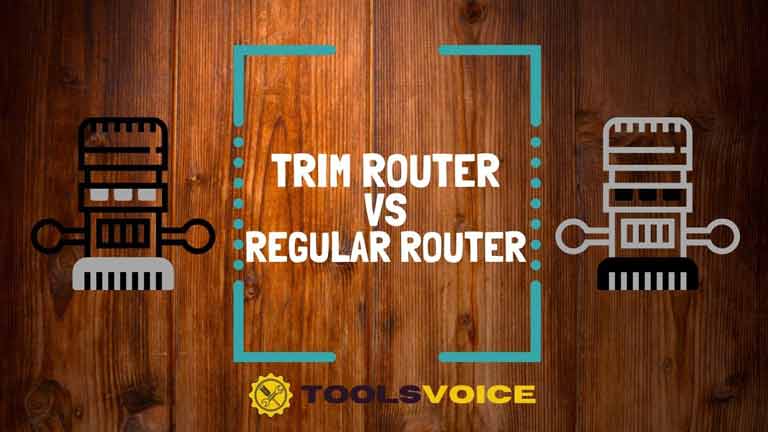The Trim Router VS Regular Router debate has been going on for a long time. It seems as though everyone is trying to figure out which one they should be using.
One of the main differences between these two types of routers is that the Trim router can only trim the edges of your wood, while you could use a regular router to shape and create wood pieces in any way you want.

In this blog post, we will compare the differences between trim routers and regular routers to help you decide which one would best suit your needs!
Difference Between Trim Router and Regular Router
The difference between a regular router and a trim router is the purpose it will serve. A trim router is designed to smooth the edges of wood while a regular router is mainly used for rough cutting.
What is a Trim Router?
A trim router is a small, handheld power tool most often used to cut decorative edges and holes in woodwork such as picture frames or window casings (trim). It’s also great for building furniture with curved shapes.

What is a Regular Router?
A regular router is a big, stationary power tool that helps you cut the shape of your choice–a circle, a wooden sign, or any other desired shape.
It’s also commonly used by contractors who need to do precision work such as routing out doorways through finished walls – where they may not be able to get enough clearance to use a trim router.

Uses
Since the trim router is smaller and lighter, it’s better for use in a workshop to build door frames, cabinets, or furniture pieces. The trim router is a smaller, more limited version of the regular router. It can be used for tasks that don’t require as much precision as other types of routers
It’s also a good choice when working with power tools because it has less weight; this feature makes the tool more manageable while being held above your head for extended periods of time.
The regular router works well with intricate edge routing, comes with larger blades that cut deeper into the wood, and produces cleaner cuts than trim routers. They can be used to cut through the board and remove a larger amount of material fast.
Moreover, trim routers can use with a router circle jig to cut a circle or hole to any desired depth without affecting other edges. A regular router cannot do this because it is limited by the size of its base plate.
A regular router operates much like a table saw where it can cut large boards with ease because of its larger base and more power. Experienced woodworkers can use it to cut dados but we recommend using a table saw that accepts dado blades to cut dados for better results.
Weight and Depth Adjustment
Regular routers are heavier, use two hands to adjust the depth of cut (which is necessary for cutting into the edge of a board), and have larger blades which make them noisier than trim routers.
On the other hand, trim routers are lightweight, easy to use with one hand, quieter than a regular router when in operation because of their smaller blade size – but you need two hands to adjust the depth which can be cumbersome at times. Plus, trim router doesn’t come with a depth adjustment tool like a regular router does.
The depth adjustment allows you to have more control over how deep into the project you go without damaging anything underneath.
The depth of cut will depend on what kind of router you’re using. When routing a groove or making large surfacing cuts, it’s best to use a standard router. For trimming purposes and more detailed work, invest in a trim router.
Routers Design
The two types of routers both have the same base components (a power cord/ battery, an on/off switch, variable speed control knob) but there are key differences in design that distinguish them from one another:
- The housing around the bit holder at the far end of the router is flat in a trim router but curved to match the shape of most regular routers
- The base plate or platform where you attach your cutting bit, on a trim router has two compartments for bits. On any other type of router, it only has one compartment
- Regular routers have an adjustable fence that can be used as a guide for routing along the edge of a board. There is no fence on a trim router
- On most types of routers, you can detach and insert different-sized cutting bits to suit various needs or projects. On a trim router, you have only one set size at any given time
Conclusion:
In this blog post, we compare trim routers and regular routers. We hope you have found this post helpful and that it has given you some valuable information to work with.
More Wood Routing Tips & Guides:
Frequently Asked Questions:
Trim Routers VS Regular Routers: Which One Should You Use?
A lot depends on your specific needs as well as which features are most important to you when it comes time to buy. If precision is key then perhaps a trim router is the right choice for you.
Trim routers are able to cut a deeper depth in one pass without affecting any adjacent sides, compared to regular routers which require multiple passes and may cause some of the edge pieces to shift out of alignment from where they need to be.
